Your notebook may be old, but that doesn't mean its days are numbered. We'll show you how to breathe new life into your portable by opening the hood and upgrading some basic components.
Christopher Null
Want better performance from your laptop? The conventional wisdom has long held that you should simply buy a new one. You can put such conventional wisdom aside: Upgrading a laptop may not be for the timid or the impatient, but if you're handy with a screwdriver, and the sight of a circuit board doesn't scare you, an upgrade can be a far more affordable solution.
We took tools to hand and worked our way through eight common (and not so common) laptop upgrades, in some instances stripping our test machines--a Dell Inspiron E1505 and a Dell Inspiron 6000--down to the bare chassis. We can't fit complete step-by-step, unscrew-this-and-unplug-that instructions for everything into this article, but we can provide tips to help with each process.
And note that every laptop varies: Even machines from the same vendor can have very different designs and therefore wildly different disassembly methods.
Before you start, keep these essential points in mind:
- Many of these upgrades will void your laptop's warranty.
- Some upgrades can damage your laptop. If you are at all uncomfortable with such tinkering, leave it to a pro.
- Most vendors provide disassembly instructions in their products' service manuals, which can usually be found on their Web sites' support sections.
- Unplug your laptop and remove the battery before attempting any upgrade. Also, to avoid damage from static electricity, use a grounded wrist strap.
- You'll need a collection of small screwdrivers, including flathead, Phillips, and possibly even Torx.
- Speaking of screws, keep them organized as you remove them. We like to use Dixie cups for each step. Just write "LCD assembly" or "keyboard" or whatever on each cup as you go, to help you remember which screws go where.
- Pay special attention to wiring. Laptops have intricate channels where the wiring must run; stray wiring may get pinched or may prevent other parts from fitting together correctly.
- No matter what machine you're working on, first upgrade your BIOS. You'll need up-to-date BIOS code to support many newer components.
- Not every laptop component can be upgraded. Some may be soldered or otherwise permanently attached.
RAM
 Time: 10 minutes
Time: 10 minutes
Adding or replacing memory has always been one of the simplest upgrades to perform on a laptop; even novice computer users should have no difficulty with it. And in our tests, this upgrade gave the most bang for the buck. On our Dell Inspiron 1525 test model, an upgrade from 1GB of RAM to 2GB (cost: $50) boosted the laptop's WorldBench 6 score from 57 to 62.
Quick tip: Use Crucial's System Scanner to find out what type of RAM modules you need. You can mix and match old modules with new ones, but some systems may end up with better performance if you install a matched pair of identical DIMM units.
You can find a selection of laptop memory modules from a variety of vendors in PC World Shopping.
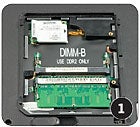 Most laptops have a panel on the underside that, when removed, exposes the DIMM slots for RAM (see photo 1 at left). (On some models, however, you must remove the keyboard to reach the slots; see the next paragraph.) To remove the panel--which is often labeled either with an M (for memory) or with a picture of a RAM chip--unscrew the holding screw or screws. Usually a single screw holds the panel in place, though some laptops may use as many as eight.
Most laptops have a panel on the underside that, when removed, exposes the DIMM slots for RAM (see photo 1 at left). (On some models, however, you must remove the keyboard to reach the slots; see the next paragraph.) To remove the panel--which is often labeled either with an M (for memory) or with a picture of a RAM chip--unscrew the holding screw or screws. Usually a single screw holds the panel in place, though some laptops may use as many as eight.
If you need to remove the keyboard, follow these steps:
- Remove the laptop's hinge cover by prying up the plastic.
- Detach the keyboard by taking out the two screws beneath the hinge cover that secure it, lifting it off, and then unplugging the connector.
(Reverse these steps when the new RAM is in place.)
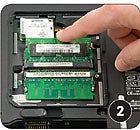 To remove an old RAM module, gently pull apart the metal clips securing each end. Once freed, it should pop up at an angle. Gently pull it straight out. Insert your new RAM in the same way, at an angle, until it is completely seated in the slot; then, again gently, press it down flat (see photo 2 at right). The holding clips will engage automatically.
To remove an old RAM module, gently pull apart the metal clips securing each end. Once freed, it should pop up at an angle. Gently pull it straight out. Insert your new RAM in the same way, at an angle, until it is completely seated in the slot; then, again gently, press it down flat (see photo 2 at right). The holding clips will engage automatically.
Replace the panel and battery, and boot up. Your computer should automatically recognize the change in RAM.
Hard Drive
 Time: 60 minutes
Time: 60 minutes
Replacing a laptop's hard drive is almost always an uncomplicated affair, and the actual swap can be done in just a few minutes. Transferring the data from the old drive to the new one requires a little more planning, and typically takes an hour or so. This simple task is likely not only to give you more storage, but also to improve performance. We upgraded a 5400-rpm, 120GB drive to a 7200-rpm, 200GB model, raising the system's WorldBench 6 score from 57 to 61.
You can find a selection of laptop hard drives from a variety of vendors in PC World Shopping.
 Hard drives are usually accessible via a side panel in your laptop and held in place by screws on the bottom. Remove those screws, and then slide the drive out of the machine (as in photo 1 here).
Hard drives are usually accessible via a side panel in your laptop and held in place by screws on the bottom. Remove those screws, and then slide the drive out of the machine (as in photo 1 here).
 The drive will most likely be attached to a sled (photo 2, at left). Remove the screws that are holding the drive in the sled, and remove the drive. Put the new drive where the old one was, and replace all of the screws in reverse order.
The drive will most likely be attached to a sled (photo 2, at left). Remove the screws that are holding the drive in the sled, and remove the drive. Put the new drive where the old one was, and replace all of the screws in reverse order.
If you are reinstalling Windows from scratch, boot from your installation disc and go to town. On the other hand, if you want to reproduce your old data and programs exactly the way you had them before, consider using cloning software to make an exact copy of the old disk. We've had great success with Clonezilla (clonezilla.org), a free tool that is command-line only but is reasonably intuitive and very fast. Finally, clone your old (now external) drive to your new (now internal) drive, and boot normally. You're done.
Optical Drive
 Time: 5 to 20 minutes
Time: 5 to 20 minutes
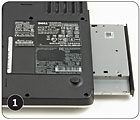 Would you like to graduate from an older CD-ROM drive to a DVD burner, or possibly even to a high-def drive? If your laptop has a modular optical drive bay (one that is equipped with an ejector switch of some kind), replacing your optical drive is easy. Buy a replacement drive, or salvage one from a compatible machine. With the laptop turned off, eject the old drive and then install the new one (photo 1, above right).
Would you like to graduate from an older CD-ROM drive to a DVD burner, or possibly even to a high-def drive? If your laptop has a modular optical drive bay (one that is equipped with an ejector switch of some kind), replacing your optical drive is easy. Buy a replacement drive, or salvage one from a compatible machine. With the laptop turned off, eject the old drive and then install the new one (photo 1, above right).
If your laptop does not have a modular drive bay, replacement usually remains fairly simple, anyway: Often a single locking screw holds the drive in place; you just unscrew it, slide the old drive out, put in the new drive, and replace the screw. In addition, you may need to install any drivers that came with the new drive.
A replacement drive should be designed for use with your specific notebook, so buy one directly from the system's original manufacturer if possible. The advantages? For one thing, this ensures that you'll have the correct IDE channel settings (which often cannot be changed) for the drive; for another, attaching the faceplate to the drive can be difficult, and it's easy to break the faceplate when removing the original drive. Vendors put the eject button in different places, too, meaning that with the wrong drive you won't be able to use the faceplate at all.
In many instances a new optical drive will work without additional tweaking. If yours doesn't work, however, download the appropriate driver; you may have to search on the full model number of the part if you didn't obtain the drive from your notebook's vendor.
Bluetooth
 Time: 10 minutes
Time: 10 minutes
Many laptops come with the wiring and circuitry to support a Bluetooth card already built in, even if they don't have the card itself installed. To avoid possible compatibility problems, however, you should obtain the Bluetooth module directly from your laptop vendor.
 On our Dell Inspiron 1525 laptop, we found the Bluetooth connector behind an odd little door in the battery bay. We merely popped open the door, pulled out the wires, and attached the Bluetooth module to it (photo 1, upper left). On some machines, the module is located near the wireless card slot; on others, it's situated under the keyboard.
On our Dell Inspiron 1525 laptop, we found the Bluetooth connector behind an odd little door in the battery bay. We merely popped open the door, pulled out the wires, and attached the Bluetooth module to it (photo 1, upper left). On some machines, the module is located near the wireless card slot; on others, it's situated under the keyboard.
Reboot, and then download and install the appropriate driver from your laptop vendor's Web site.
Wireless Card
 Time: 15 minutes
Time: 15 minutes
Upgrading a wireless card is usually about as easy as upgrading RAM. In fact, on some machines, both the Wi-Fi card and the RAM are located under the same panel.
The trick is to make sure that you install a compatible part. Most laptops that were made a few years ago use Mini PCI cards, while newer ones use the Mini PCI Express standard. The latter type of cards have two separated sets of connectors along the narrower side; Mini PCI cards have only one set.
Even if the card you get has the right connector, it may not automatically work in your laptop: It's unlikely that you can upgrade your old 802.11b card to an 802.11n one (since few 802.11n Mini PCI cards have been made), but it's very likely that you'll be able to find an 802.11a/b/g card that works. Also, many systems that shipped with 802.11g cards can be upgraded to meet the latest 802.11n standard. To avoid firmware incompatibilities, we advise you to get this part directly from the manufacturer of your laptop; in any case, it should be sold specifically for your computer.
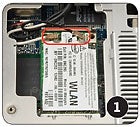 Once you have the right part, the upgrade is a snap. If your wireless card is under the keyboard, as ours is, remove the keyboard (see the next paragraph), locate the card (photo 1 at left), and disconnect the two antenna wires (one white, one black) by pulling straight up on the connectors; don't pull on the wires themselves (see photo 2, below).
Once you have the right part, the upgrade is a snap. If your wireless card is under the keyboard, as ours is, remove the keyboard (see the next paragraph), locate the card (photo 1 at left), and disconnect the two antenna wires (one white, one black) by pulling straight up on the connectors; don't pull on the wires themselves (see photo 2, below).
If you need to remove the keyboard, follow these steps:
- Remove the laptop's hinge cover by prying up the plastic.
- Detach the keyboard by taking out the two screws beneath the hinge cover that secure it, lifting it off, and then unplugging the connector.
(Reverse these steps to replace the keyboard when the new card is in place.)
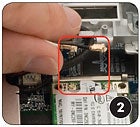
Remove the old card by pulling apart the two holding clamps on the card's sides and then pulling the card straight out (photo 3, below). Insert the new card, and reattach the antennas by pushing the connectors straight down on the plugs.
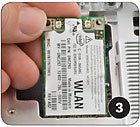
If your wireless card is located on the underside of the machine, flip the notebook over, remove the appropriate panel, and follow the instructions above.


No comments:
Post a Comment